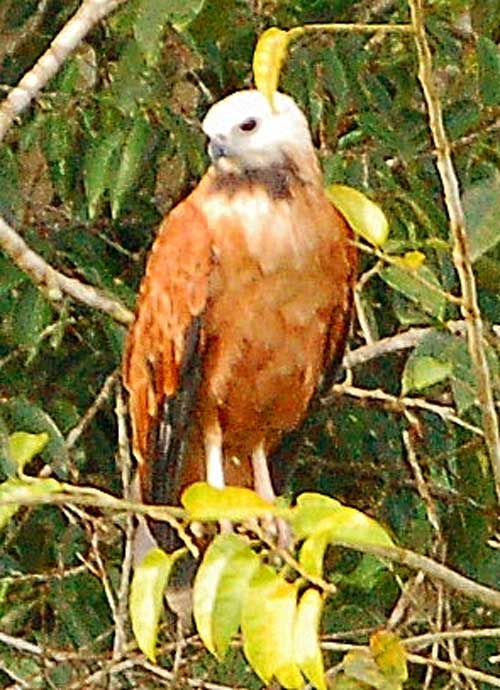
Busarellus nigricollis
Superregnum: Eukaryota
Cladus: Unikonta
Cladus: Opisthokonta
Cladus: Holozoa
Regnum: Animalia
Subregnum: Eumetazoa
Cladus: Bilateria
Cladus: Nephrozoa
Superphylum: Deuterostomia
Phylum: Chordata
Subphylum: Vertebrata
Infraphylum: Gnathostomata
Megaclassis: Osteichthyes
Cladus: Sarcopterygii
Cladus: Rhipidistia
Cladus: Tetrapodomorpha
Cladus: Eotetrapodiformes
Cladus: Elpistostegalia
Superclassis: Tetrapoda
Cladus: Reptiliomorpha
Cladus: Amniota
Classis: Reptilia
Cladus: Eureptilia
Cladus: Romeriida
Subclassis: Diapsida
Cladus: Sauria
Infraclassis: Archosauromorpha
Cladus: Crurotarsi
Divisio: Archosauria
Cladus: Avemetatarsalia
Cladus: Ornithodira
Subtaxon: Dinosauromorpha
Cladus: Dinosauriformes
Cladus: Dracohors
Cladus: Dinosauria
Ordo: Saurischia
Cladus: Eusaurischia
Subordo: Theropoda
Cladus: Neotheropoda
Cladus: Averostra
Cladus: Tetanurae
Cladus: Avetheropoda
Cladus: Coelurosauria
Cladus: Tyrannoraptora
Cladus: Maniraptoromorpha
Cladus: Maniraptoriformes
Cladus: Maniraptora
Cladus: Pennaraptora
Cladus: Paraves
Cladus: Eumaniraptora
Cladus: Avialae
Infraclassis: Aves
Cladus: Euavialae
Cladus: Avebrevicauda
Cladus: Pygostylia
Cladus: Ornithothoraces
Cladus: Ornithuromorpha
Cladus: Carinatae
Parvclassis: Neornithes
Cohors: Neognathae
Cladus: Neoaves
Ordo: Accipitriformes
Familia: Accipitridae
Subfamilia: Buteoninae
Genus: Busarellus
Species: Busarellus nigricollis
Subspecies: B. n. leucocephalus – B. n. nigricollis
Name
Busarellus nigricollis (Latham, 1790: 35)
Original combination: Falco nigricollis Latham, 1790
References
Latham, J. 1790. Index ornithologicus, sive systema ornithologiæ; complectens avium divisionem in classes, ordines, genera, species, ipsarumque varietates: adjectis synonymis, locis, descriptionibus, &c. Volumen I: pp. i–xviii, 1–466. Londini. (Leigh & Sotheby). BHL Reference page. [original description: p. 35]
Vernacular names
čeština: Káně černohrdlá
English: Black-collared Hawk
español: Águila colorada
polski: Tarczownik
português: Gavião-belo
The black-collared hawk (Busarellus nigricollis) is a species of bird of prey in the family Accipitridae. It is monotypic within the genus Busarellus.[3] It has a widespread range of presence, from western Mexico to Uruguay. Its natural habitats are subtropical or tropical moist lowland forests, subtropical or tropical swamps, and swamps.[1]
The adult black-collared hawk has a more or less white head, tinged with buff, and with black shaft streaks on the crown. The body, above and below, and the mantle are bright cinnamon-rufous, paler on the chest. There is a black crescent on the upper breast. The back has scattered black shaft stripes; the flight and tail feathers are black with the base of the tail barred with rufous. The eyes are bright reddish brown, the cere and bill black, and the legs bluish white. Immatures are similar, but blotched with black, including on the crown, and the rufous barring on the tail is more extensive. The pale area on the chest is also more clearly marked. The upper surface of the wings is barred, and the eyes are brown.
The nest is usually placed in a large tree, frequently near water, but sometimes in shade trees in coffee plantations or suburban areas. The nest is lined with green leaves. The female lays three to five eggs, dull white, spotted with pale yellow-brown or red-brown and a few darker freckles. There is no further information on its reproduction.
The black-collared hawk lives on a diet mainly composed of fish. It also eats water bugs and occasionally lizards, snails and rodents.
In the 1870s, Ridgeway wrote that Busarellus (then known as Ichthyoborus) had the "general form and appearance of Buteogallus aequinoctialis", but that it "is much more nearly related to the heliatine groups", in which he included Milvus, Haliastur, and Haliaaetus.[4] During the early-to-mid 20th century, Busarellus was conventionally placed near Buteogallus in taxonomic order.[4]
The black-collared hawk has the basal phalanges of the inner toe fused, which may be an adaptation to prevent the toe from bending back when catching prey. This feature is shared with Ictinia and with the group of true milvine kites and sea eagles (Milvus, Haliastur, Haliaaetus, and Icthyophaga).[4] Research in molecular phylogenetics during the early 21st century indicates that there is a clear milvine–haliaetine clade that is related to a large group of buteonine hawks and their relatives. Within the buteonine group, Ictinia is near-basal, and Busarellus is a member of a clade shared with Geranospiza, Rostrhamus, and Helicolestes.[5]
References
BirdLife International (2020). "Busarellus nigricollis". IUCN Red List of Threatened Species. 2020: e.T22695842A168782089. doi:10.2305/IUCN.UK.2020-3.RLTS.T22695842A168782089.en. Retrieved 12 November 2021.
Gill F, D Donsker & P Rasmussen (Eds). 2020. IOC World Bird List (v10.2). doi : 10.14344/IOC.ML.10.2.
"ITIS Report: Busarellus". Integrated Taxonomic Information System. Retrieved 13 March 2013.
Olson, Storrs L. (1982). "The distribution of fused phalanges of the inner toe in the Accipitridae". Bulletin of the British Ornithologists' Club. 102 (1): 8–12. Contains a detailed section on the relationship of Busarellus.
Peters, Alan P. "Taxonomy in Flux Checklist: Accipitriformes". Zoonomen. Retrieved 8 April 2016.
Retrieved from "http://en.wikipedia.org/"
All text is available under the terms of the GNU Free Documentation License

